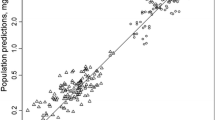Summary
The pharmacokinetics of free and total valproic acid (VPA) in plasma and whole blood after oral administration during steady state was investigated in seven infants (mean age 10.7 months) receiving monotherapy. The VPA concentrations in whole blood closely followed those in plasma but at a reduced level. A positive correlation was found between dose and mean plasma concentration (r=0.71). Mean terminal half-lives were similar in plasma and whole blood (12.5 and 15.5 h, respectively), but were considerably longer than for free VPA (6.4 and 6.5 h, respectively; P<0.01). There was a significant decrease in half-lives with increasing age (P<0.05). Plasma and whole blood clearance for total VPA was higher than reported in older infants and adults (17.8 and 28.9 ml/kg per hour) and was considerably higher for free VPA (127.6 and 188.8 ml/kg per hour, respectively). The increase in clearance compared with that in older subjects is well in concordance with a lower protein binding of VPA (mean 85.3%). Of special importance is that the percentage of unbound VPA increased with increasing concentrations of total VPA. The fraction of unbound VPA in plasma increased even more in subjects with low albumin concentrations (P<0.01).
Similar content being viewed by others
References
Bowdle TA, Patel IH, Levy RH, Wilensky AJ (1980) Valproic acid dosage and plasma protein binding and clearance. Clin Pharmacol Ther 28:486–492
Bruni J, Wilder BJ, Willmore LJ, Perchalski RJ, Villarreal HJ (1978) Steady-state kinetics of valproic acid in epileptic patients. Clin Pharmacol Ther 24:324–332
Dreifuss FE, Santilli N, Langer DH, Sweeney KP, Molin KA, Menander KB (1987) Valproic acid hepatic fatalities: a retrospective review. Neurology 37:379–385
Ehrnebo M, Agurell S, Boréus LO, Gordon E, Lönnroth U (1974) Pentazocine binding to blood cells and plasma proteins. Clin Pharmacol Ther 16:434–439
Gamstorp I (1985) Paediatric neurology, 2nd edn. Butterworth, London, pp 114–117
Gibaldi M, Perrier D (1982) Pharmacokinetics, 2nd edn. Dekker, New York
Gugler R, Meuller G (1978) Plasma protein binding of valproic acid in healthy subjects and in patients with renal disease. Br J Clin Pharmacol 5:441–446
Herngren L, Nergardh A (1988) Pharmacokinetics of free and total sodium valproate in adolescents and young adults during maintenance therapy. J Neurol 235:491–495
Kilpatrick CJ, Bury RW, Fullinfaw RO, Moulds RFW (1987) Plasma concentrations of unbound valproate and the management of epilepsy. Aust NZ J Med 17:574–579
Kriel RL, Cloyd JC, Green KH, Sawchuk RJ, Lockman LA, Eggerth R (1979) The pharmacokinetics of valproic acid in children. Ann Neurol 6:179
Levy RH, Shen DD (1989) Valproate, Absorption, distribution and excretion. In: Levy RH, Dreifuss FE, Mattson RH, Meldrum BS, Penry JK (eds) Antiepileptic drugs. Raven Press, New York, pp 583–599
Lewandowski C, Klug S, Nau H, Neubert D (1986) Pharmacokinetic aspects of drug effects in vitro: effects of serum protein binding on concentration and teratogenicity of valproic acid and 2-en-valproic acid in whole embryos in culture. Arch Toxicol 58:239–242
Lundberg B, Nergårdh A, Boréus LO (1982) Plasma concentrations of valproate during maintenance therapy in epileptic children. J Neurol 228:133–141
Riva R, Albani F, Cortelli P, Gobbi G, Perucca E, Baruzzi A (1983) Diurnal fluctuations in free and total plasma concentrations of valproic acid at steady state in epileptic patients. Ther Drug Monit 5:191–196
Riva R, Albani F, Franzoni E, Perucca E, Santucci M, Baruzzi A (1983) Valproic acid free fraction in epileptic children under chronic monotherapy. Ther Drug Monit 5:197–200
Riva R, Albani F, Contin M, Baruzzi A, Altomare M, Merlini GP, Perucca E (1984) Mechanism of altered drug binding to serum proteins in pregnant women: studies with valproic acid. Ther Drug Monit 6:25–30
Rowland M, Tozer TN (1989) Integration with kinetics. Clinical pharmacokinetics, 2nd edn. Lea & Febiger, Philadelphia, pp 177–193
Siemes H, Spohr HL, Michael T, Nau H (1988) Therapy of infantile spasms with valproate: results of a prospective study. Epilepsia 29:553–560
Tarasidis CG, Garnett WR, Kline BJ, Pellock JM (1986) Influence of tube type, storage time, and temperature on the total and free concentration of valproic acid. Ther Drug Monit 8:373–376
Zimmerman HJ, Ishak KG (1982) Valproate-induced hepatic injury. Analysis of 23 fatal cases. Hepatology 2:591–598
Author information
Authors and Affiliations
Rights and permissions
About this article
Cite this article
Herngren, L., Lundberg, B. & Nerg»rdh, A. Pharmacokinetics of total and free valproic acid during monotherapy in infants. J Neurol 238, 315–319 (1991). https://doi.org/10.1007/BF00315328
Received:
Revised:
Accepted:
Issue Date:
DOI: https://doi.org/10.1007/BF00315328




